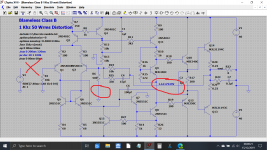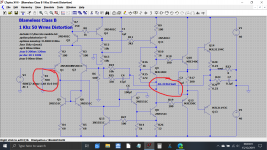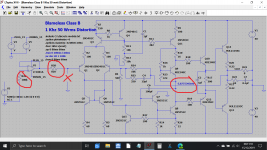I'm looking for a power amp that can reproduce infra-sound from near DC to 30Hz or so. This amp needs to power a subwoofer that is rated at 150 watts RMS into 8 ohms. My research has determined that a direct coupled amp design is the way to go but so far I cannot find a suitable amp. The closet that I have come is a vintage Technics SU-V3 Stereo Integrated DC Amplifier with a FR of 2Hz to 100kHz. Unfortunately it's power output is only 40 watts per channel into 8Ω (stereo). I then thought that I could build an amp on a board but I am having trouble finding a suitable design. Can anyone point me to a design or a consumer amp that can meet my needs?
Thanks,
Scott
Thanks,
Scott
Last edited:
Many amplifiers can be persuaded to operate down to DC with a little tweaking. Essentially you need an amp that can be trimmed to give zero DC offset when the feedback is DC coupled.
Do you really need a response down to DC? If we are talking audio then you don't, if it is for some other application then you might.
Do you really need a response down to DC? If we are talking audio then you don't, if it is for some other application then you might.
You're going to find amps with protection will prevent subsonic frequencies, as they are seen as fault conditions, even if you remove any DC blocking caps in the amp input.
Its pretty universal for amp inputs to have a DC-blocker cap - this is easy to bypass.
Its common for feedback networks to have unity DC gain via a capacitor in the lower part of the divider chain - again this can be bypassed (DC offset will then rise).
Any amp with a DC servo is out of the game, unless figure out how to rework it.
Don't forget class-D amps - some may be easy to adapt (class D topologies are usually inherently DC capable, again its a case of removing any DC-blocking caps).
For very low frequecies you have to de-rate a speaker considerably as it cannot self-ventilate as effectively to cool itself.
Its pretty universal for amp inputs to have a DC-blocker cap - this is easy to bypass.
Its common for feedback networks to have unity DC gain via a capacitor in the lower part of the divider chain - again this can be bypassed (DC offset will then rise).
Any amp with a DC servo is out of the game, unless figure out how to rework it.
Don't forget class-D amps - some may be easy to adapt (class D topologies are usually inherently DC capable, again its a case of removing any DC-blocking caps).
For very low frequecies you have to de-rate a speaker considerably as it cannot self-ventilate as effectively to cool itself.
That 150 watt sub will not put out anything audible below 20 hz so why bother. You need 100 time as much acoustic power at 20 hz as at 1khz to sound the same loudness ( Fletcher Munson). The sub at 20 hz is probably not nearly as efficient as your other speakers so that 100 to 1 could be as high as 500 to 1. At 10 hz, forget it. And good luck finding any music with 10hz in it.
Try this. Get a friend to move a large piece of plywood back and forth as fast as they can. Maybe get 5 hz. Can you hear the 5 hz? So 10 sq feet of diaphram with a 1 foot excursion and nothing. How much is that sub gonna put out.
To all who have replied:
Thanks for your responses but no one has answered my question. Mooly is right ... the
HiFi Engine - Owners and Service Manuals database has many power amps that meet my needs but finding one at a good price is the challenge. So I'm leaning toward building my own direct coupled power amp that can support DC to 30Hz but I need a design before I can get started.
Thanks
Scott
Thanks for your responses but no one has answered my question. Mooly is right ... the
HiFi Engine - Owners and Service Manuals database has many power amps that meet my needs but finding one at a good price is the challenge. So I'm leaning toward building my own direct coupled power amp that can support DC to 30Hz but I need a design before I can get started.
Thanks
Scott
Try this. Get a friend to move a large piece of plywood back and forth as fast as they can. Maybe get 5 hz. Can you hear the 5 hz? So 10 sq feet of diaphram with a 1 foot excursion and nothing. How much is that sub gonna put out.
Thanks for the suggestion but you have not answered my question.
I think before any of us can give you a good answer, we need to know what you are trying to accomplish...
If you're trying simply to have "more bass" and think that infrasonics is the answer, I have to agree with a couple of others who've pointed out that you simply cannot hear at those low frequencies.
Then there's the issue of "weaponized sound"... You can feel infrasonic vibrations on various parts of your body but that's a rather dangerous game to play. Some interpret it as an earthquake, others develop severe vertigo, otheres are moved to apparitions, still others can be induced into seizures and permanent hearing damage is common with only brief high level exposures. There have been numerous incidents of theatres playing with this and causing panic in their audiences, with some very bad outcomes. A more recent example was the mysterious illness of diplomats in Cuba.
Infrasonics have also been tested in demolition, as an alternative to explosives. Simply find a building's resonant frequency and vibrate it hard enough and it will come down.
That's some serious bad ju-ju.
All that said, there are a number of industrial servo drivers that can deliver thousands of watts at extremely low frequencies, right down to DC. These are normally motor controllers but if you think about it a speaker is just a DC position servo that happens to move air.
There are also quite a few pro-audio amplifiers that will get down to 2 or 3 hz at respectiable power levels, the Crown XLS series for example.
If you're trying simply to have "more bass" and think that infrasonics is the answer, I have to agree with a couple of others who've pointed out that you simply cannot hear at those low frequencies.
Then there's the issue of "weaponized sound"... You can feel infrasonic vibrations on various parts of your body but that's a rather dangerous game to play. Some interpret it as an earthquake, others develop severe vertigo, otheres are moved to apparitions, still others can be induced into seizures and permanent hearing damage is common with only brief high level exposures. There have been numerous incidents of theatres playing with this and causing panic in their audiences, with some very bad outcomes. A more recent example was the mysterious illness of diplomats in Cuba.
Infrasonics have also been tested in demolition, as an alternative to explosives. Simply find a building's resonant frequency and vibrate it hard enough and it will come down.
That's some serious bad ju-ju.
All that said, there are a number of industrial servo drivers that can deliver thousands of watts at extremely low frequencies, right down to DC. These are normally motor controllers but if you think about it a speaker is just a DC position servo that happens to move air.
There are also quite a few pro-audio amplifiers that will get down to 2 or 3 hz at respectiable power levels, the Crown XLS series for example.
I'm need this amp to drive a rotary subwoofer. The amp will only drive the speaker motor sans speaker cone and cage. The speaker motor will drive five variable pitch fan blades.
So what you really need is a PWM motor speed controller...
I'm need this amp to drive a rotary subwoofer. The amp will only drive the speaker motor sans speaker cone and cage. The speaker motor will drive five variable pitch fan blades.
It would have been really useful to know this up-front....
If its a commercial unit please post the datasheet. If you are home-brewing one that's going to be an interesting project.
I think before any of us can give you a good answer, we need to know what you are trying to accomplish...
If you're trying simply to have "more bass" and think that infrasonics is the answer, I have to agree with a couple of others who've pointed out that you simply cannot hear at those low frequencies.
Then there's the issue of "weaponized sound"... You can feel infrasonic vibrations on various parts of your body but that's a rather dangerous game to play. Some interpret it as an earthquake, others develop severe vertigo, otheres are moved to apparitions, still others can be induced into seizures and permanent hearing damage is common with only brief high level exposures. There have been numerous incidents of theatres playing with this and causing panic in their audiences, with some very bad outcomes. A more recent example was the mysterious illness of diplomats in Cuba.
Infrasonics have also been tested in demolition, as an alternative to explosives. Simply find a building's resonant frequency and vibrate it hard enough and it will come down.
That's some serious bad ju-ju.
All that said, there are a number of industrial servo drivers that can deliver thousands of watts at extremely low frequencies, right down to DC. These are normally motor controllers but if you think about it a speaker is just a DC position servo that happens to move air.
There are also quite a few pro-audio amplifiers that will get down to 2 or 3 hz at respectiable power levels, the Crown XLS series for example.
For all the reasons you have mentioned that why I must build it! Just need help with the amp solution.
It would have been really useful to know this up-front....
If its a commercial unit please post the datasheet. If you are home-brewing one that's going to be an interesting project.
Home brew ... already built. just need an amp solution
For all the reasons you have mentioned that why I must build it! Just need help with the amp solution.
Actually I gave you more reasons not to build it.
Please clear my doubts, I´m straight answering your original question but need more details.Home brew ... already built. just need an amp solution
As I see it, unlike any type of "piston" speaker, your modulated fan CAN go down to DC.
In fact, all fans produce Acoustic DC, just unmodulated.
In yours, blades rotate at constant speed and output is produced by varying blade pitch ... please confirm/deny.
IF so, a DC supply drives the electric motor, and Audio power drives the blade actuators. Yes/No
IF so, please provide the actuator schematic, with coil data: drive voltage needed, and resistance/impedance.
If none of this applies and you actually want to drive a bidirectional rotary motor with Audio, then I´m out of this, sorry.
Good luck with your project.
To all who have replied:
Thanks for your responses but no one has answered my question. Mooly is right ... the
HiFi Engine - Owners and Service Manuals database has many power amps that meet my needs but finding one at a good price is the challenge. So I'm leaning toward building my own direct coupled power amp that can support DC to 30Hz but I need a design before I can get started.
Thanks
Scott
Lets do a quick hatchet job on the Blameless Class B... and this will show how to approach altering any suitable design
We remove the input coupling cap and short out the feedback return cap. This amp is actually pretty good and gives a DC offset in this state of under 2 volts DC.
The imbalance at this point is caused by the 10k input resistance R1 and the 500 ohm feedback return R6.
So we make R1 approximately 500 ohm. The offset is now less than 100mv.
You now have a small problem of actually driving the DC coupled amp because the input impedance has to remain at that 500 ohm level. One option is to add an opamp in front with a 500 ohm series resistor (you can tweak the value to get zero volt DC offset at the final amp output. This now allows for us to set the overall input impedance to whatever we wish (100k here).
Cautions...
A relay delay at the output would be mandatory because switch on and probably switch off will not be pretty in terms of transients generated.
The opamp should probably be a FET type like an OPA134 etc.
Higher power can be achieved by using two or possibly three pairs of output transistors.
All this would be a starting point for converting an amp to DC operation.
Attachments

Here is a DC-capable but DC-stable circlotron amp. It will need more paralleled P-channel MOSFETS on the output to lower distortion and lower output impedance. I have not optimized this amp yet, so distortion is way to high. See it as fast and rough early draft.
I would prefer some IXYS devices (IXTN120P20T) on the output instead of IR/Infineon devices, but I don´t know how to add those to LTSpice.
- Home
- Amplifiers
- Solid State
- Looking for an Infrasonic amplifier



